A 1937 British thriller involving a family of counterfeiters in an Austrian mountain resort, this rare feature was directed by Bernard Vorhaus, a visual stylist whose handling of conventional genre material in the U.S. and England has made him the focus of several retrospectives in Europe. Starring Jane Baxter, Ronald Squire, and Margaret Rutherford, the film features impressive mountain scenery and some exciting cliff-hangers. (JR) Read more
From the Chicago Reader (November 1, 1987). — J.R.
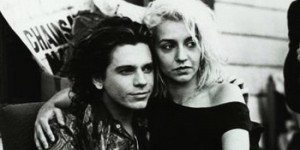
Judging from this interminable Australian punk film, the 1978 freak scene in Melbourne was almost identical to that in London a decade earlier, with one important difference: politics in this motley crash pad are so marginalized that they barely squeak into the movie as incidental comic relief. Writer-director Richard Lowenstein seems as bored with the proceedings as most spectators are likely to be; consequently there’s probably more gratuitous camera movement per square inch here than in any other film of 1986. The house where all the layabouts lay about belongs to Sam (Michael Hutchence), lead singer for the rock band Dogs in Space, and in order to justify the title further, period snatches of TV coverage of astronauts are arbitrarily cut into the proceedings. Boredom is counter-revolutionary, reads a prominently placed placard, but the boredom in this case — scarcely alleviated by the ‘Scope format and a few intermittent flashy visual effects — isn’t even focused enough to seem moderate. The Dolby music in the film is written and performed by Iggy Pop, Brian Eno, the Marching Girls, Chuck Rio, Gang of Four, and Boys Next Door; other actors include Saskia Post, Nique Needles, Deanna Bond, Tony Helou, and Chris Haywood. Read more
Richard Attenborough’s epic 1987 account of South African journalist Donald Woods (Kevin Kline) and his friendship with black activist and martyr Steve Biko (Denzel Washington) infuriatingly devotes most of its 158 minutes to the former rather than the latter, and what begins as a stirring mainstream account of the meaning of Biko’s politics and legacy eventually becomes a protracted tale of Woods and his family’s escape from South Africa, in order that he might tell the truth about Biko’s death at the hands of the police. Giving Biko the Gandhi treatment may have its educational uses, and the first half of the film builds up an effective sense of outrage about apartheid in general and the persecution of Biko in particular. But turning this story into yet another version of the nobility of the White Man’s Burden effectively undercuts the radical importance of Biko’s movement for the sake of flattering the liberal white audience’s sympathies; the results are watchable, but ultimately specious. With Penelope Wilton as Woods’s wife; screenplay by John Briley, adapted from Woods’s books Biko and Asking for Trouble. (JR) Read more
It’s rare that two actors are expected to carry an entire picture, but this winsome lark with Martin Short and Annette O’Toole is predicated on just that, and succeeds delightfully. The encounter is both archetypal and very contemporary: it’s their third date, each of them has high hopes, and both have things to conceal from each other. Armyan Bernstein, who wrote One From the Heart, collaborated on the script with Gail Parent and directed, and Lawrence Kasdan, of all people, produced, but it’s Short and O’Toole who carry the show throughout; all but a few of the movie’s 96 minutes are devoted to the date, and they keep it fresh, sexy, and unpredictable. It’s a nice demonstration that the most overworked of comic formulas can still work if sparked with the right insights and personalities. (JR) Read more
A first feature by former French journalist Stephanie de Mareuil, Coeurs croises follows the amorous tribulations of a group of women living in the same apartment house in rue Saint-Denis, the major prostitute district of Paris. This sentimental and partially comic new film ends with actress-singer Caroline Loeb’s hit song, C’est la ouate. (JR) Read more
Shirley Temple is rescued from a shipwreck by lighthouse keeper Guy Kibbee, but the nasty forces of the law want to separate her from her newly found guardian. David Butler directed, and Temple and Buddy Ebsen dance At the Codfish Ball (1936). Read more
Elsa Lanchester plays an uptight missionary trying to reform a beach bum (Charles Laughton) in this 1938 romantic comedy directed by Erich Pommer, adapted from W. Somerset Maugham’s short story The Vessel of Wrath. Not to be confused with Muriel Box’s inferior 1954 remake with Glynis Johns and Robert Newton in the leading roles, this is reportedly the best of all the Laughton/Lanchester collaborations, and in some respects a precursor of The African Queen. On the same program, a rare, silent shortone of a series of three made by British film writer Ivor Montagu in 1928Bluebottles is a slapstick comedy written specifically for Elsa Lanchester, with Laughton in a small role as a gangster. Read more
From the Chicago Reader (November 1, 1987). — J.R.
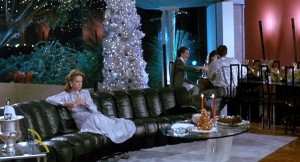
Reefer Madness comes to Beverly Hills in the affluent 80s. Perhaps not since Midnight Express had we gotten so much sanctimony and glitz simultaneously; while the earlier film worked up a righteous indignation about the conditions of Turkish prisons — not for Turks but for well-bred Americans — this 1987 movie reserves all its pity about the ravages of cocaine burnout for the children of multimillionaires. Adapted by Harley Peyton from Bret Easton Ellis’s novel, the story focuses on three high school graduates — an upright college kid (Andrew McCarthy), his former girlfriend (Jami Gertz) who now works as a model and dabbles in coke, and a would-be record producer and disco manager who’s fatally hooked on the stuff (Robert Downey Jr.) and follows their tribulations through the Christmas holidays. Marek Kanievska (Another Country) directs with relentlessly fancy visuals in a series of opulent southern California settings; Ed Lachman’s cinematography is letter perfect as always in its handling of light and color (assisted here by Barbara Ling’s flashy production design), but it’s a pity to see it wasted on such claptrap. (JR)
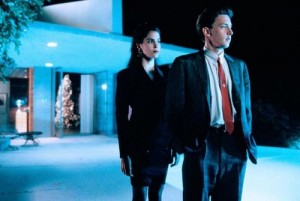 Read more
Read more
From the Chicago Reader, November 1, 1987. — J.R.
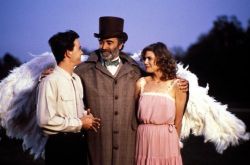
Alan Rudolph’s movie begins promisingly: Mike (Tim Hutton), out of work in the mid-40s (in black and white), dies in an accident and finds himself in heaven (in color), where he’s greeted by his amiable Aunt Lisa (Maureen Stapleton), and shortly falls in love with Annie (Kelly McGillis), an unborn soul. Heaven here is rather like Ray Bradbury’s Mars, a site of nostalgic wish fulfillments, and if Rudolph and screenwriters Bruce A. Evans and Raymond Gideon had only remained there, the movie might have somehow sustained its fragile, otherworldly charm. But Annie leaves to be born on earth, and Mike, who’s allowed to be reborn, is given 30 years to find her again. Inexplicably, the film remains in color as it returns to earth; the new selves of Annie and Mike still look the same, but how they’re supposed to find one another with fresh identities and nearly blank memories is not made clear, and vagueness gradually gives way to muddleheadedness. Although a string of cameos by nonactors (including novelist Tom Robbins and various rock singers) leads to some awkward moments, Rudolph still shows some talent in handling professionals (such as Ann Wedgeworth and Don Murray, as well as the leads), though he’s invariably better off when directing his own scripts (e.g., Read more
As a bracing alternative to the steady diet of straight story films and talking-heads documentaries of the Chicago Film Festival–as well as the hit-or-miss selection that makes random viewing a very high risk venture–the experimental shorts at the fourth annual Onion City Film Festival offer a breath of fresh air. Apart from the intriguing-sounding Chicago-Frankfurt Film Exchange, which is being offered as a separate special event (see listings), two three-hour programs have been put together representing work all across North America, and the overall quality and diversity of talents on display are impressive indeed. Judging from the ten films I’ve seen, comprising about a third of the selections, there are no major breakthroughs, but a lot of interesting and energetic forays. Today Is Sunday, a lovely black-and-white, elliptical seminarrative by Chicago performance artist Jean Sousa, gravitates around a beachside location and is punctuated by suggestive, free-floating intertitles and isolated bursts of music. Chick Strand’s Artificial Paradise, shot over three years in Mexico, interweaves a kaleidoscope of colorful visual and aural textures in dancelike rhythms; Alex Prisadsky’s short and silent Dmitri and Ramona performs a sprightly jig of its own using only printed words. Domenic Angerome’s Continuum does wonderful things with tar, paint, and other aspects of urban street work in striking high-contrast black-and-white photography that evokes the 30s, while Scott Guitteau’s Advanced Civilized Nation makes politically provocative use of found footage. Read more
From the Chicago Reader (October 26, 1987). — J.R.
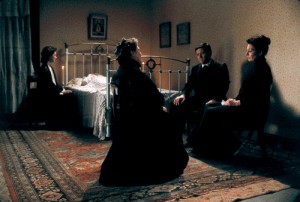
John Huston devoted the better part of his career to a sort of intelligent second-degree cinema predicated on the adaptation of literary worksa practice informed by crafty casting and fluid storytelling, but often limited by the fact that his attraction to heavyweights (The Maltese Falcon, The Red Badge of Courage, Moby-Dick, The Man Who Would Be King, Wise Blood, and Under the Volcano, among others) guaranteed faithful reductions at best. His last film (1987), which adapts the final story in James Joyce’s Dubliners, represents the apotheosis of this position — isolating the story from the rest of Dubliners (which gives it much of its resonance) and most of its perfectly composed language, and then doing his best with what remains. Scripted by his son Tony and starring his daughter Anjelica, the film hews to the original plot and much of the dialogue. The results are leagues ahead of Joseph Strick’s unfortunate Joyce adaptations, but inevitably leagues behind the original story. That said, the film’s concentrated simplicity and purity achieve a kind of perfection. The uniformly superb cast includes Donal Donnelly, Cathleen Delany, Helena Carroll, Ingrid Craigie, Frank Patterson, Dan O’Herlihy, and Donal McCann as Gabriel Conroy; the lilting Irish flavor is virtually decanted, and Fred Murphy’s gliding camera movements are delicately executed. Read more
The 23rd Chicago International Film Festival, running from Monday, October 19, through Sunday, November 8, promises 131 separate programs, not counting repeats. As a newcomer to this event who has attended about a dozen other international film festivals, most of them several years in a row, I can offer at this point only a single, broad generalization about what seems to make Chicago’s relatively pluralistic and amorphous, for better and for worse.
Although film festivals come in all shapes and sizes, one can generally make a loose distinction between the free-for-alls, where anything and everything is likely to turn up (Cannes, London, Los Angeles’s Filmex), and the ones with a more discernible selection process that tend to project a more critical and polemical profile (Toronto, New York, Rotterdam). By reputation and to all appearances, Chicago belongs more in the first category than in the second. What this means in practice is that the shopping spectator has to become his or her own critic while browsing through the festival schedule, rather than trust in either fate or some imagined philosophical unity in director Michael Kutza’s selections.
Practically speaking, with a festival this size, taking some initiative is what everyone has to do anyway. Read more
Cantonese director Yim Ho’s delicate and touching film charts the return of Coral (Josephine Koo), an attractive Hong Kong businesswoman in her thirties, to her native village in southern mainland China. Staying with her childhood friend Pearl (Si Quin Gao Wa)–now a school principal married to a farmer, with a daughter-she discovers that her urban life and problems have irrevocably estranged her from the ways and attitudes of the village, although she and Pearl make many heartfelt efforts to bridge their differences. Kong Liang’s screenplay eschews melodrama and big events for quiet insights, and a remarkably dense portrait of the village emerges, framed by Ho with a distinctive grasp of composition, landscape, and personal detail that occasionally evokes the complexity of a Brueghel. The performances are nuanced and moving, and one comes to know these people–not only the heroines, but Pearl’s defensive and tongue-tied husband, an unruly and mercenary little boy, a man who can’t read the letters in English his son sends him from UCLA, a wise uncle, and many others–on a first-name basis. (Facets Multimedia Center, 1517 W. Fullerton, Saturday, Tuesday, and Thursday, October 3, 6, and 8, 9:00, 281-4114) Read more
There are many pleasant surprises in this collection of 18 animated shorts from ten countries, but perhaps the biggest one is that the range of influences informing animation seems to be getting wider. While the terminal cuteness of Disney and the gallows humor of Eastern Europe have tended to dominate in the past, and are far from absent here, the more vernacular genius of Tex Avery also seems to be making some headway–in such diverse works as Bon Kurtz’s parodic Drawing on My Mind from the U.S., Guido Manuli’s Plus One, Minus One (a screwball remake of It’s a Wonderful Life) and Bruno Bozzetto’s Baeus (a doodle-bug variation on Avery’s King Size Canary) from Italy, and Joanna Quinn’s Girl’s Night Out from Great Britain, which plays with some Averyesque gags on striptease and libido from a female Cockney point of view. There’s also striking hyperrealist computer animation from the U.S., clay animation from the Soviet Union and Hungary, and the usual batch of glum parables from all over. But my favorites in this batch strike out freshly on their own: Susan Young’s semiabstract Carnival, which beautifully evokes a London ethnic street fair; Academy Leader Variations, the most avant-garde selection which combines the giddy talents of 20 animators from the U.S., Read more
A fair to middling liberal courtroom thriller set in Washington, D.C., this Peter Yates picture takes a while to get started, and never tells us as much about its major characterspublic defender Kathleen Riley (Cher), juror and lobbyist Eddie Sanger (Dennis Quaid), and derelict and murder suspect Carl Wayne Anderson (Liam Neeson)as we’d like to know. But there’s some interesting material about the plight of the homeless (a subject not broached by many 80s movies), and effective performances by Joe Mantegna (as the prosecuting attorney) and John Mahoney (as a stern judge). (JR) Read more





